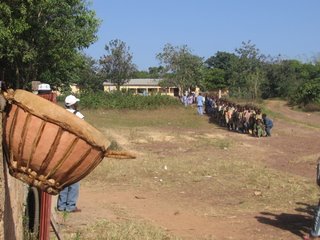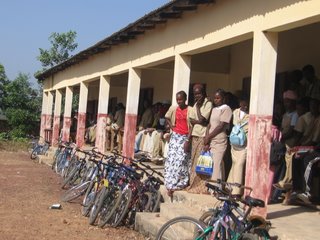Tor, Diana, and I went for a 5 day hike through Dogon Country in eastern Mali, near the Burkina Faso border. The Dogon people who inhabit the villages along the escarpment have fascinating animist beliefs. Some villages are split into Animist, Christian, and Muslim sections.

Dogon Symbology on a Granary
The crocodile is sacred to the Dogon. The legend is that when the Dogon went to leave their living place and search for a new one, they went to take the remains of an important elder from his grave. They found a big black snake in the grave instead. They followed the big black snake to the escarpment where they settled. They wandered around thirsty, but couldn't find water. A giant crocodile flicked water down at them with his tail from on top of the escarpment, leading them to the water and allowing them to settle there. We fed a chicken to the crocodiles in the sacred crocodile pool in Amani, one of the villages at the base of the escarpment. When Dogon people find a dead crocodile, they take it and bury it like a human in their graveyards up in the caves in the cliffs.

Diana checking out a Tellem house
The Tellem were the small red-skinned people that the Dogon found living in the cliffs. They say that the Tellem ate fruit and meat from the forests below. When the Dogon cleared the forests for agriculture, it forced the Tellem out. The Dogon say that the Tellem had magical powers or that they could fly, because their small houses are very high in the cliffs and inaccessible today. Others think that the climate has changed and long vines used to grow down the cliffsides, giving the Tellem access to their homes.

Canarys (storage containers) in a Tellem house

Begnamoto, A Village on Top of the Escarpment
You can see the white mask at the bottom right of the photo, hidden behind the boulder outside of the village. Men hide their masks like this outside of the village in an area where women and children cannot pass. This particular mask calls for rain. The top cross reaches to the sky and the bottom cross reaches to the earth. No one may talk about which mask they wear or identify themselves in the dance. They dance with masks at set periods during the year (to dance for the rains, for example). Only men wear the masks and women and children cannot approach the dance. One exception is that women born on Thursdays in June may dance!

Tor and Diana Bargaining for Bogolan (Mud Cloth)

Teli, A Village at the Base of the Escarpment
Teli is a predominantly Muslim village today. You can see the mud mosque at the bottom left of this picture. The village of Teli moved down from the cliffs into the plains in the 1970s.

















 Refugee Perks in Bamako
Refugee Perks in Bamako













 Musee D'Orsay
Musee D'Orsay

















